

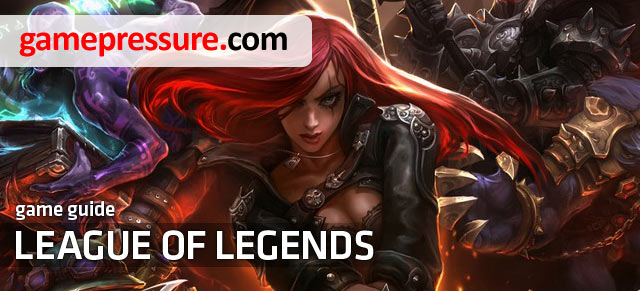
This guide to League of Legends contains tips for new players who are just beginning their adventure on the Fields of Justice - right from the registration to the first steps in the game.
The first chapter introduces the game's dictionary, abbreviations, and phrases. The second chapter details on the basic gameplay, including character's control, combat and special abilities, earning gold, and map orientation. The next chapter introduces would-be Summoners to the world of Fields of Justice, and describes all in-game maps, which serve as battle arenas for the leagues: Summoner's Rift, Twisted Treeline, Howling Abyss and The Crystal Scar.
Another, equally important, part of the guide contains description of types of heroes and details on their role in team. After acquainting yourself with champions' roles, we advice you to chose one of the 9 heroes recommended for beginners, introduced below.
The text describes the game's client functionality and the GUI (Graphical User Interface). You will also find some information on buying additional items, which may help you defeat other champions.
The guide is complemented with detailed maps, showing all important capturable buildings - such as towers, inhibitors, an nexus - the best spots to place wards, and also places where you can meet neutral NPC jungle dwellers.
Lukasz "Qwert" Telesinski ()
This dictionary explains phrases and abbreviations used further in the guide and in the game itself. Knowing them will considerably improve team communication and, essentially, make it faster. In the heat of battle there rarely is time to construct elaborate sentences, and that's when the abbreviations really come in handy. For your convenience, the dictionary entries are sorted in alphabetical order.
League of Legends is a MOBA (Multiplayer Online Battle Arena) type of game. Two teams of 3 or 5 players battle each other on a chosen map. The game's objective is to destroy the key building in enemy base - the Nexus. Reaching that goal is not as simple as it may seem. The gameplay combines use of skill and tactics, and there are many roads to victory. There are plenty of things that a player needs to keep an eye on, such as map visibility, enemies spotted on the lane, as well as those who may suddenly appear on the frontline. Outnumbering your opponent may often turn out to be the key to success. LoL offers three game modes: Classic (maps: Summoner's Rift and Twisted Treeline), Dominion (The Crystal Scar), and ARAM (Howling Abyss), which are detailed further in the guide.
League of Legends is based on microtransactions. Downloading and playing the game is free. All in-game champions, runes, and runebook pages can be purchased with IP (Influence Points), which are awarded to each player for their sheer participation in battles. Real money can be spent on RP (Riot Points), which allow players to buy additional skins for their champions. Skins are just a visual aspect - they do not influence champions' statistics. Another benefit of having RP is that you can spend them to immediately purchase champions of your interest. Only runes are available exclusively for IP. Owing to its attractiveness and mechanics LoL has quickly become the most popular e-sport in the world.
To create an account, click Registration button on the main site or use this link: https://signup.leagueoflegends.com/pl/signup/index.

In this box, you need to fill in all necessary data and choose your region. To do this, click change button. The most popular regions are North America, EU WEST and EU Nordic & East. The choice of region determines which nationalities will be dominating on the server. After filling in the data and choosing the region, click Play for Free button.
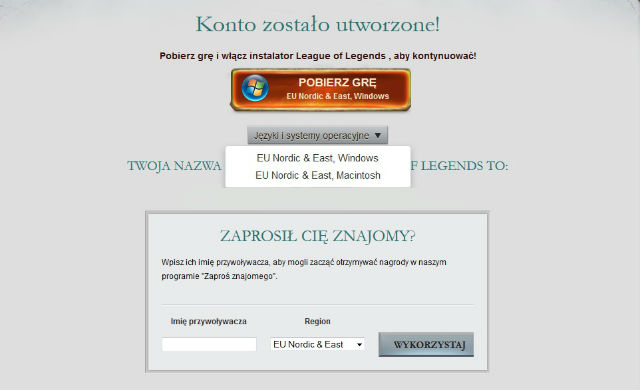
When the registration is complete, a message will appear saying that your account has been created. If you had not yet downloaded LoL client on your hard disc drive, now would be the perfect time. The installation program is available for Windows and Macintosh. If your friends already play LoL, you might want to type in their name and choose the right region from the Referred by a friend? window, to give them access to rewards from Refer a Friend program. These are usually additional IP, awarded for referring a friend.
Mastering the controls to a degree that you intuitively use abilities significantly improves the gameplay. This is why it is good to get acquainted with the custom controls and, if needed, adjust it to your own preferences in the game settings.

Click RMB somewhere on the map to move your champion around. The same stands for standard attack. Just point the mouse over a target and click RMB.

These buttons stand for champions' special abilities.

These buttons stand for spells selected afore hand by the summoner.

Numbers from 1 to 6 stand for the items in your inventory. You can press the buttons to drink healing potions, use vials, or activate items that give bonuses.

When you select an ability and click LMB, the champion will perform an attack depending on the ability chosen.

With combinations of numbers from 1 to 6 plus LMB you can e.g. use an item which deals damage to your target or put down a Ward.

Rolling the mouse wheel up or down will adjust the zoom level.

The Alt + LPM combination will open a small screen with four options. Using them in a given location on the map will inform the teammates that an enemy is not where he should be, warn them against danger, ask for help, or point your next destination.
Smart Cast setting may be useful in for some champions. It enables faster use of abilities and items during combat. This option is available via controls settings.
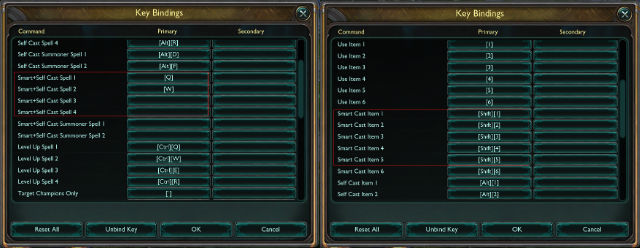
If an ability or an item is set in this way, just point the mouse over a target and select the ability, and the champion will perform the action.
Map visibility plays a huge role in League of Legends. Most of the map is covered with the Fog of War, which prevents players from seeing what happens on the covered area, untill they or one of their teammates send there their champion. The map may also be uncovered by minions, some champions' abilities (e.g. Nidalee's traps or Caitlyn's snares), as well as global ult (e.g. Ashe's Crystal Arrow, Ezreal's Trueshot Barrage), which fly across the entire map. However, the most popular way to sustain the map visibility is setting down Wards. Those can be bought in the game's store.
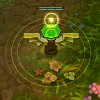
Stealth Ward: The regular Wards, which are available at the shop for 75 gp. They reveal a small fragment of the map, for 3 minutes, after which they disappear. They can be destroyed by the opponent if, he e.g. put a Vision Ward nearby or used the Sweeping Lens. Each of the heroes can have only 3 wards of this type and simultaneously, there can only be, up to, 3 Stealth wards on the map, per player.
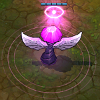
Vision ward: It is the, so called, Pink, i.e. a pink Ward. It is available at the shop for 100 gp. It is more expensive, because it reveals the nearby area, and the invisible units in that area, until it is destroyed. Each one of the heroes can only have 2 such Wards at a time. Each player can only deploy one Vision Ward on the map.
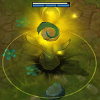
Warding Totem: the so called Trinket, which can be obtained at the shop, completely free of charge. After you use this item, you can place an invisible Ward in a place of your choice, which remains active for 60 seconds (recharging of the totem takes 120 seconds) Trinkets cannot be used for the first 90 seconds of the game. Selling the Trinket (e.g. in order to exchange it for another one) blocks the ability to use them for 180 seconds. On level 9, the ward Totem transforms into the Greater Totem.
Using Wards and Trinkets is easy. You only need to:
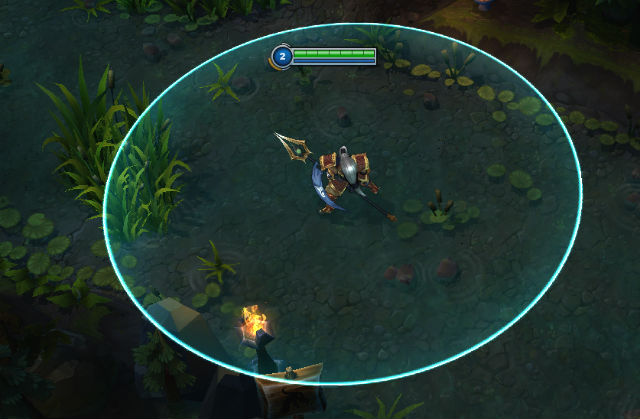
Press the right button (numbers from 1 to 6), depending on which slot contains Wards. This will create a ring around your champion within which the Ward can be put down. This way you can put it on the other side of a small wall or similar obstacle without risking your life, or when you are expecting that your enemy is hiding in bush. Wards' cast range gives you some space for quick reactions.
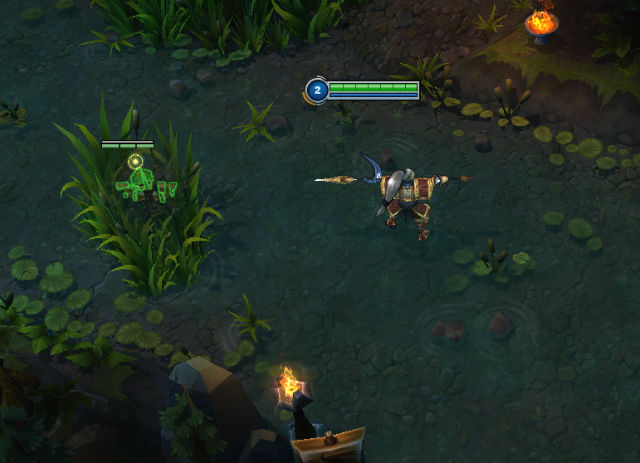
Clicking RMB will put down a Ward and uncover the surrounding area. All enemies walking by that place will be discovered and marked on the minimap.
Inform of enemy movement
You are farming on a lane, and all of a sudden you are attacked by 4 enemies. Skillful deployment of Wards can prevent such surprises and buy you some time for reaction, as well as warn your teammates.
Wards can help protect key objectives
Deploying Wards close to the Baron, the Dragon, or Buffs enables your team to quickly respond to enemies' attempt to capture one of the objectives. Pinks can also drain the opposing team's vision giving them a cause to worry.
Wards as Gank preventers
There are many bushes on the map, where enemies can hide waiting to ambush an unsuspecting victim. If, in turn, they come across a Ward, they can become an easy target themselves.
Wards give tactical advantage
champions playing on the Top or the Mid often have Teleport as one of the summoner spells. Thus they can teleport to a Ward and cut off enemy's retreat.
Since your team is not the only one who will use Wards, it is important to prevent the enemy from getting too much map visibility. This will ease the game, especially for Jungler, who Ganks a lot. You can disturb enemy vision in two ways: by drinking the Oracle's Extract, which enables you to detect enemy Wards within a certain range, or with aforementioned Pinks. The enemy can be deprived of vision in two ways: after using the Greater Lens (a Trinket) , or with the abovementioned Pinks.
There are three types of Trinkets in League of Legends and they can be helpful in different aspects of the gameplay:

Warding Totem: After it is used, it places an invisible totem, in a specified place, which then remains active for 60 seconds. The Totem takes 120 seconds to recharge. At level 9, it can be upgraded, with gold, to Greater Stealth Ward or to the Greater Vision Ward.

Sweeping Lens: After it is used, it revels and deactivates all of the nearby invisible traps and Totems, for 4 seconds, within a small radius of its operation. The Sweeping Lens upgrades to Greater Lens at level 9 and it can be upgraded even further, to the Oracle's Lens.

Scrying Orb: After being used, it reveals a small area within distance of, up to, 1500 units, for one second. During that time, the enemy heroes will be visible on the map for 5 seconds. At level 9, the Scrying Orb turns into the Greater Orb, after which it can be upgraded to the Farsight Orb, with gold.
Trinkets cannot be used for the first 90 seconds of the game. Each one of the Totems can be obtained at the shop at the beginning of the game, free of charge, and upgrade it later on, to the option that you want (a free or a paid one). A Totem can be sold at any moment or exchanged for another one, which you find more useful at a more advanced phase of the game. In this case, after a Trinket is sold, the ability to use them is blocked for 180 seconds.
Farming means earning gold for killing minions. Initially farming is slow, but it changes over time. Good farming can get you better and better items, thus making your champion stronger. Farming is indicated by Creep Score (CS), which measures how many minions and neutral monsters you have killed. CS increases ONLY through Last Hitting, i.e. dealing the final blow to a target.

Melee Minion: Charges at enemy champions or minions and attacks them at close quarters. Each wave includes 3 minions of the type. They have more health than Caster Minions. Killing each grants 22,5 gold (+0,5 gold with each following cycle).

Caster Minion: These creatures are positioned behind the Melee Minions
and attack from a distance with bolts of energy. Each wave includes 3 Casters. They are much weaker than Melee Minions, and because of that are they provide less gold. Killing each grants 16,5 gold (+0,5 gold with each following cycle).

Siege Minion: Much stronger than the previous minions. Born to destroy towers, as it receives 50% less damage from them. One Siege Minion appears in every third cycle (and every other cycle after the 35th minute of the game. They are much more resistant than Melee Minions and deal more damage. Killing each grants 40 gold (+1 with every third cycle).

Super Minion: The strongest of all minions. They are summoned only after an Inhibitor is destroyed. Like Siege Minions, they get 50% less damage from towers. After all Inhibitors are down, every wave will contain two, instead of one Super Minion. Killing each grants 27 gold.
Minions are summoned on the map in minute 1:30 of the game. They come out of Nexus in lines and start marching down the lanes. Each consecutive wave starts after 30 seconds (this is a so-called Cycle). Every 3 minutes (or every 6 cycles) minions grow stronger and consequently, champions get more gold and experience for killing them.
The picture shown in this chapter presents user interface of an ADC (Attack Damage Carrier) champion. The UI's layout is the same for all champions, varying only in abilities icons and statistics. Player's achievements and time played are displayed at the top-right corner of the screen. There is also information about FPS and ping. At the bottom-right corner there is the minimap, which shows current situation on the arena. The grey area indicates the Fog of War. champion's abilities and Summoner Spells are in the centre of the screen, at the bottom. The level of an ability rises after clicking small plus icon next to the ability. At the bottom-left corner of the screen there is a champion's icon, his current level, experience bar, and a list of items in inventory. Below that, there is the gold meter, which additionally serves as the store access.
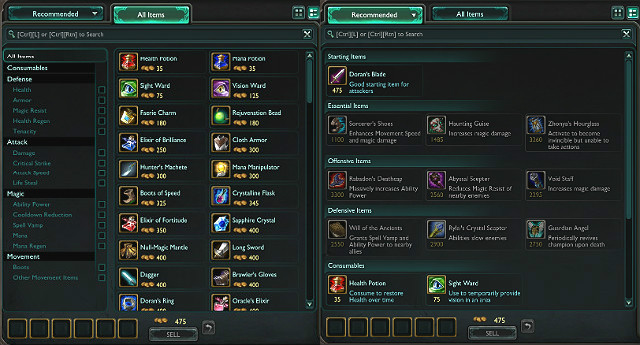
As explained earlier, throughout a game players earn gold, which can be spent on additional items, so their champions could grow stronger. Items store is divided into different categories: consumables (e.g. potions, wards), defense (armour, magic resist), attack (attack speed or damage), magic (ability power, mana regeneration), and movement (boots, attack items). Additionally, each champion has his own tab with recommended items, which suggests what may be worthy of your hard-earned gold. After expanding the recommended tab, you can replace it with an beforehand prepared card of item sets. Purchased items will appear in one of 6 small boxes at the bottom. You can also sell them (using sell button) to reclaim some of the gold spent on them.
There are 3 game modes in League of Legends, each of them will provide much excitement, and help to develop your skills.

In PvP two 3- or 5-player teams fight against each other on a chosen map in one of 3 game modes: Classic, Dominion, and ARAM. Classic mode is further divided into Normal or Ranked games.
Normal games:
The most popular type of game, which basically serves as testing ground for new champions, tactics, items sets, or as a warm-up before ranked games. Both won and lost battles reward players with IP and experience (if they have profile level below 30). Normal games can be played solo (players sign up individually) or with others (by inviting 1 to 4 players). Opponents are matched basing on players' level and skill. Single game lasts from 20 to 50 minutes, but there have been very short battles, which lasted less than 20 minutes. Normal games can be set as: Blind Pick or Draft Mode.
Blind Pick
Each player chooses a champion. Members of opposing teams cannot see each other's line-up until the loading screen shows up. Because of this, sometimes there are the same champions in two teams; e.g. there may be 2 Shens in two opposing teams.
Draft Pick
This option brings a doze of tactics. Initially, captains from both teams can lock 3 champions from the opposing team, thus excluding them from the game. Then, one of the teams gets so-called First Pick, i.e. right to choose a champion as first. After that, the other team picks 2 champions. The pattern goes until all players have a champion. Finally, players can exchange their champions with people from their team. In that case scenario, both players who decide to exchange need to had bought the other champion.
Ranked Games:
The third season of League of Legends saw the old "ELO" system (relative skill levels of players) replaced with league system. To compete, players must have at least profile level 30 and own 16 or more champions (league games do not use the weekly free pool of champions). The win/lost result of the first 10 ranked games decides about players' position in ranks affiliation in the leagues. The lowest-ranked league is Bronze V and the highest-ranked - Gold II/I. Players may rank up by participating in more games.
League types
Symbol
Name
Symbol
Name

Bronze

Platinum

Silver

Diamond
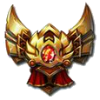
Gold

Challenger
Each league has 5 divisions (V - being the lowest, I - the highest). Both leagues and divisions are represented by players of similar skills. Players earn League Points for won battles, and lose them through lost battles. If in a given division, take Silver V, a player earns 100 points, he will be admitted to promotion games, which can promote him to the next division, in this case Silver IV. To be promoted to the next division, the player have to win 2 out of 3 promotion games. Promotion to the next league, let's take Silver I to Gold V, requires winning 3 out of 5 games. The Challenger has its own rules. There are no divisions; players simply earn League Points. The more points they get, the higher their position in the rank is. This league is meant for highly skilled players, so-called Pro gamers, who often earn real money from playing LoL. This is the league that gathers the most famous players from all around the world.
Just like in Draft Pick in Normal game, players in league games choose their champions in turns. If a player Dodges at this point, i.e. shuts down the game (e.g. because he feels uncomfortable about the line-up), he gets a time ban (cannot join any game for the next 6 minutes) and loses 3 league points. If he does it again, he will have to wait another 30 minutes and lose 10 points. Dodging during promotion series will hinder his promotion by taking away a dozen points - so he has to earn the full 100 points again to be admitted to another promotion series. Players who spend too much time in one league or lose to many battles, will be matched with players from lower divisions (e.g. a Silver II player will be set up against Silver III-V or Brown I players). This will result in earning less points for won games and losing more points for lost ones. When that happens, earning promotion to another division gets much more difficult. Players cannot be demoted on the level of leagues - e.g. a player from Gold cannot drop to Silver. However, they can be demoted to lower divisions, if they do not participate in ranked games for more than 28 days or if they lose to many times in row.

In this mode a team of 3 or 5 players fight against Bots (AI controlled champions). This can also be played solo or with others in one of 2 difficulty levels: beginner and intermediate. Participation in these games is awarded with less IP than the PvP games. This mode is recommended especially to beginners, so they could get familiar with the game's mechanics before they try their skill against other players. Moreover, at the very beginning playing Co-op vs. AI mode is the fastest way of getting experience, because the games are usually much shorter.
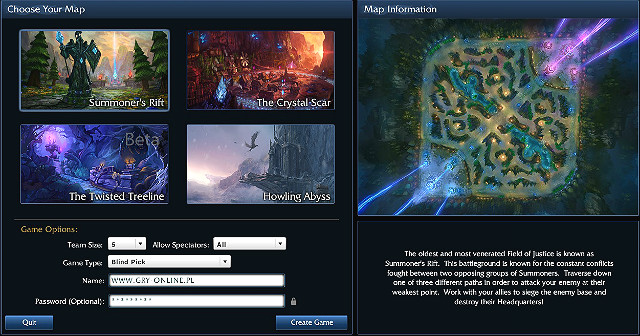
This option allows players to create their own games on one of 4 in-game maps or join other, already existing games. Customizable options are: number of players in team, game mode, game name, and password, should it be a private battle. Custom games are a good way to examine your skill in 1 vs. 1 or 5 vs. 5 (full team) battles.
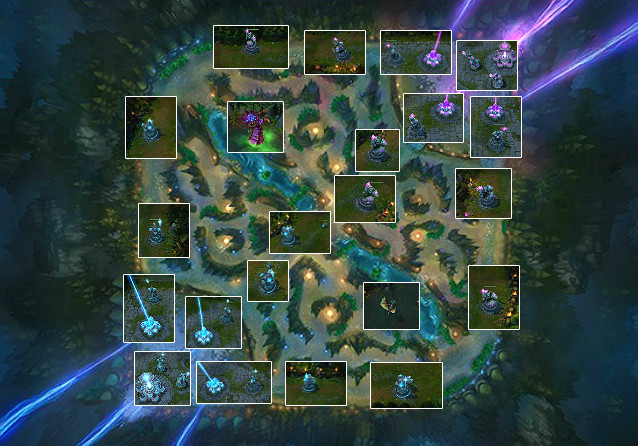
Tower
Nexus
Inhibitor
Baron Nashor
Dragon





Summoner's Rift is the first and the most popular map in League of Legends. This is where the tournament and world championship 5 vs. 5 games take place. The map is divided into two identically shaped parts - the Blue and the Purple. The battleground is crossed by three lanes: the Mid, the Top, and the Bottom. Each lane is guarded by three Towers and each base has three Inhibitors - one for each lane. Nexus is guarded by another two towers. The lanes are surrounded by adjacent jungle, which occupies the most of the map. In the jungle there are many neutral creatures, assigned to different camps. Both Blue and Purple parts of the map are divided by shallow water inhabited by the two most powerful creatures in the game: the Dragon and the Nashor. Killing former is awarded with 190 gold, and the latter - 300 gold along with a buff. Battles fought on this map are three-phased. Victory can be won either by destroying the enemy Nexus or forcing the opposing team to surrender.
Starts right after champions are spawned on the map. Usually at this moment players buy starting items. Champions do not have all their abilities yet and they are weak and vulnerable to damage. This is the right time for players to take positions on their lanes, where they can both farm and gain experience (hence the Laning Phase). The progression is slow - champions are barely able to finish off minions, not to mention killing hordes of monsters. It is then best to focus on Last Hitting and, from time to time, if the moment is right, you may poke your opponents, so they did not feel too secure. This is also the time when junglers' aggressive ganks are very common. The ending result of phase one greatly depends on farming. The more gold champions get, the better items they have in phase two. Early Game usually ends with taking down the first tower.
In this phase most champions will already have armed themselves with essential early items. This is now a good time to build numerical superiority on lanes: 4 vs. 3, 3 vs. 1 etc. This will help to eliminate opponents and take down enemy towers. At the same time, you should also keep an eye your own Turrets, since an unguarded alley makes an alluring and easy target for adversaries. Pick your targets carefully, because they may come back to bite you. At this point in game champions can push (kill minions by dozens), and consequently they farm faster. In phase two, your champion should already be armed with one or two mid game items. They will come in handy in inevitable team fights. Mid Game is also a good moment to control and kill the Dragon. Phase Two usually ends when most towers of a one team are destroyed.
In this phase most champions will already have armed themselves with essential final items. At this point any bad decision may turn into defeat, regardless of earlier advantage. Each team fight must be well-thought-out and targets picked carefully. This is a good time for luring out the opponents, capturing and controlling Baron, and eliminating all enemy Wards. Note that champions who die during this phase will have to wait 60-70 seconds before they respawn, so one victorious team fight may end the game.

Tower
Nexus
Inhibitor
Altar
Vilemaw





Twisted Treeline is the second of the basic maps. Champions line up in two, instead of three lanes. The tempo of the game is faster than on the Summoner's Rift. The map is set horizontally, and the jungle area are much smaller than those on the previous map. The alleys are guarded by two Towers and one Inhibitor, while Nexus is protected by only one additional Turret. Both teams are made up of three champions, who, due to small size of the map, often try to ambush their opponents. There are two altars in the heart of the jungle. Those can be captured by standing on top of them. This provides useful buffs: extra gold for killing creatures or physical and magic damage. In the very centre of the jungle there is another altar with a red cross. This one regenerates a small portion of health and provides movement speed bonus. The strongest creature on Twisted Treeline is Vilemaw - an arachnid version of Baron. It resides in a separate bay in the northern part of the map. Killing it provides 194 gold and a positive aura that improves champions movement speed, health and mana/energy regeneration, and lowers cooldowns of their abilities. The game ends with destroying the enemy Nexus or one team's surrender.
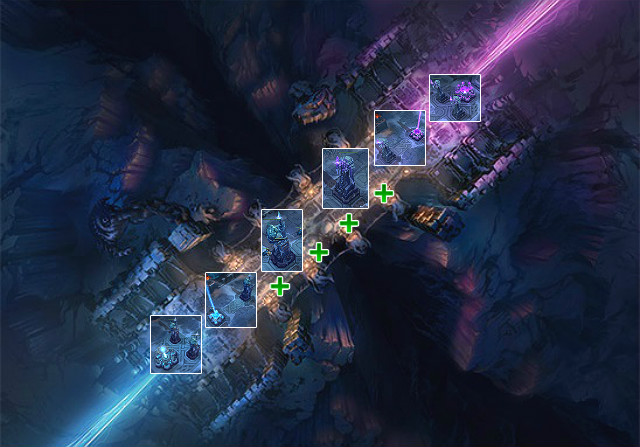
Tower
Nexus
Inhibitor
Relic




This is the popular ARAM mode (All Random All Mid). The map was probably built for players who would creat games, where everyone had a random champion and had to play on the Mid on the standard Summoner's Rift. Since the release of Howling Abyss, players no longer have to wangle like that. The developer met these needs by creating a map with just one lane and randomly assigned champions. Players start at level 3 and already have much gold. Next shopping can be done only after death, so the items should be wisely chosen right at the start. Unlike on Summoner's Rift, the starting platform does not heal players, so do retreating there will do you no good. Instead, you can use one of the healing relics placed along the lane. Each part of the map is guarded by two Towers and an Inhibitor, and Nexus is protected by two additional Turrets. After the enemy Inhibitor is down, each minions wave will include two Super Minions, who can cause a lot of trouble. Since all players are focused at one spot, the gameplay is even more dynamic, as its focused on team fight rather than farming. The game ends when a Nexus is down or one of the teams surrenders.
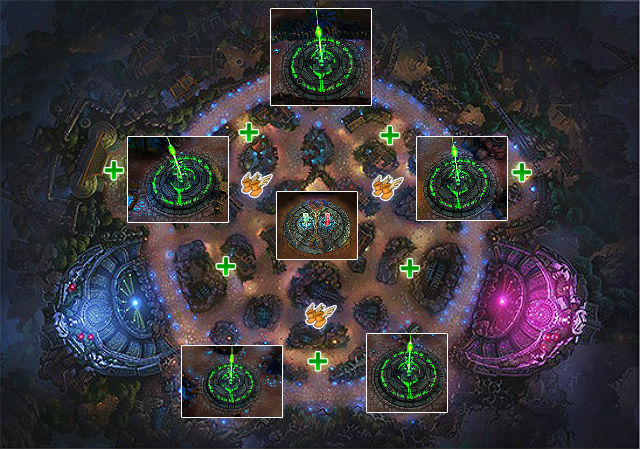

The Windmill: The Windmill used to supply the village with power. This is the most important place on the map and is located in its northern part at the same distance from both teams' starting points. This is where the toughest team fights happen.

The Drill: Located in the north-east of Kalamanda. This is a former excavation site, hence the area is covered with deep holes and huge drills sticking out from the ground. This spot is closer to the Purple team, but it still can be a luring target for the opponents.

The Boneyard: Here, a skeleton of a huge reptile was found, whose skull and bones still sick out of the ground. The Boneyard is in the south-eastern part of the map. This is another point with an easy access for the Purple team.

The Quarry: This is where the village took the resources from. Around the altar there are abandoned buildings, where stone used to be refined. This point, on the other hand, is closer to the Blue team's starting point, in south-west.

The Refinery: A concentration of buildings and machinery designed to exploit magical resources. This point is in north-west part of the map, closer to the Blue team's starting point.

The Seal: The Seal lies in the center of the The Crystal Scar. This serves as a graveyard for fallen heroes. Champions can get powerful buffs from here.

Boots: This marks whirls, which will provide you a movement speed bonus, when you walk through them.

Relic: This marks medkits. Walking through them will immediately restore a small portion of health.
This is the map designed for Dominion game mode, which is based on capturing strategic points (the Windmill, the Quarry, the Drill, the Boneyard, and the Refinery). Initially, all of them are neutral and easy to capture. To take over a point you just need to click on it and wait a moment, and of course, survive. When a team has captured most of the points, the enemy Nexus will start to receive damage over time. Similarly to Howling Abyss, players start at level 3 and receive 1375 gold. The map is round-shaped and has a small marketplace at the center, where you can buy movement speed bonuses and medkits. This is also where quests are given - completing them will provide powerful buffs to an entire team.
There are many champions in League of Legends. Each plays a particular role in his team and is equipped with unique abilities. You can choose a champion from the ones you had purchased or from the weekly free pool, either motivated by your own likenings or by your teammates' suggestions. Champions have different play styles - that divides them into following categories.
Champions from this group of specialize in quick finishing off adversaries (mainly AP and AD Carry) who are the most valuable for the opposing team. Such champions often have wide range of abilities which can easily distract opponents (such as disappearing act, stun, slow, fear). Assassins focus on dealing damage (so-called DPS), so they spend their gold on items which enable them to cause much damage in a short period of time. Playing as Assassin requires good timing, because you need to eliminate your target fast enough not to become an easy pray yourself.
Strengths
Weaknesses
+ huge damage dealt to a single target
+ varied abilities
+ spreads havoc among enemy ranks
- very vulnerable to damage
- weak against tanks
- require a lot of skill

These champions are well-balanced between attack and defense. Can deal some serious physical or magical damage, and, when necessary, serve as living shields to protect more fragile teammates. They usually have abilities which enable them to quickly start a fight and stick by the opponent (taunt, stun). They specialize in dealing Damage Over Time.
Strengths
Weaknesses
+ high effectiveness in early game
+ good at 1 vs. 1 encounters
+ area damage
+ crowd control abilities
- lose their value in later phases
- need time to finish off an opponent
- weak against ranged champions, such as marksmen

In most cases these champions are best at distance, thanks to their magical abilities. Typical mages have powerful skills aimed at dealing damage to a single target or area damage, as well as abilities impairing opponent's movement. Their main task is to deal damage, so they are often vulnerable to enemy attacks. Unguarded mage is a dead mage. To avoid close encounters with an enemy, mages hide behind fellow tanks or fighters, where they can serve their role undisturbed.
Strengths
Weaknesses
+ high magical damage
+ crowd control abilities
+ good at eliminating Supports, ADC
- very vulnerable to damage
- often defenseless against a good Fighter or a Tank
- effective use of mana and cooldowns requires much skill

Ranged champions who deal physical damage mostly through AA (Auto Attack), though there are also ADC focused on abilities. Many of them have crowd control abilities (slow, stun, knockback) along with those, which, when developed, improve the champions statistics (damage, attack speed, etc.). ADC's role is to constantly harass enemies by attacking their most important champion with AA. They usually spend their gold on items improving AD (Attack Damage), as well as on those regenerating health while attacking. Marksmen are the key damage carriers in late phase, which makes them the primary target for the enemy. Hence, they need protection from Tanks/Supports.
Strengths
Weaknesses
+ huge physical damage
+ indispensible in late game
+ crowd control abilities
- require much gold
- vulnerable to damage
- require much skill

These champions are born to support their team through healing or stats improving abilities (armour, magical skills, attack speed, etc.). They also have a selection of crowd control abilities, which can easily distract enemies, thus causing them to make mistakes. Support's place is by the side of ADC, usually on the Bottom. His main tasks is to sustain map visibility, prevent enemy ganks, and protect ADC through various shields or healing. Another important task is to keep enemies at bay and sometimes initiate a fight. Supports are often taken for granted, however, a good Support is a key to success.
Strengths
Weaknesses
+ team supporting abilities
+ crowd control abilities
+ healing
- no match for other champions (Mage, Fighter etc.) in 1 vs. 1 encounter
- underestimated
- require much skill and creativity

These champions are characterised by their high armour, endurance, and health stats. They also have crowd control abilities, however, they are very poor at dealing damage. Tanks' main tasks are to attract enemy attacks and keep opponents in one place, so other teammates could focus on dealing damage. Tank is the one to launch attacks and spearhead the invasion. A moment of hesitation or bad timing may cost a teammate his life or turn into defeat. A good tank knows when to retreat, as to protect the key champions from their team.
Strengths
Weaknesses
+ really hard to kill
+ can single-handedly protect a lane
+ crowd control abilities
- low damage
- vulnerable to harassment in phase one

Champion who, due to their abilities, can easily kill neutral creatures in the jungle. Their job is to create numerical superiority on lanes through ganks and providing buffs, securing the Dragon, and the Baron. A good jungler is a key to success. The very thought of an enemy champion hiding somewhere out there may cause opponents to make dire mistakes, which you can easily take advantage of. Junglers often venture into enemy territory to deprive their opponents of neutral creatures, thus slowing down enemy Jungler's development (so-called Counter Jungling).
Strengths
Weaknesses
+ can help teammates on every lane
+ jungle control
+ element of surprise
- player needs to know the regeneration times of buffs, Dragon, Baron, and other creatures in the jungle
- player must make quick and relevant decisions, so as to evoke an impression of being in many places at the same time
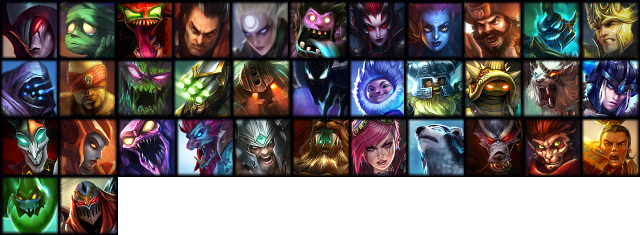
Each champion in League of Legends can support their team in their own way. They are divided into categories for a reason - the division suggests what are the particular champion's strengths, which can be effectively used in battle.
Their main task is to eliminate specific targets. Their strength lies in items improving damage. Because they attack from a distance, they always need to care the right position, so as not to suddenly find themselves on the line of enemy fire. Initially, they are carried by their teammates, so they could freely collect gold needed for essential items. When they earn the items, the roles switch, so ADC become carries, i.e. lead their team to victory.
One of the most important things ADC need to master is good farming, i.e. earning gold through last hitting minions or neutral creatures. This way of getting gold is much more important than killing other champions. Saying that kills are unnecessary may be somewhat of an overstatement, but they are rather just a nice addition to regular farming, measured by CS (Creep Score - the number of minions and neutral creatures killed). A good ADC will not let a single creature pass through, even if killing it would require using his abilities. That requires a lot of training and good knowledge of a champion.
Another important role is DPS (Damage Per Second), since in late game ADC are capable of dealing huge damage. If they die, the team loses its driving force. This is why they need constant protection from Tanks, Fighters, and Supports. From behind the frontline they can focus on staying alive and eliminating the most important and the most dangerous targets: AD/AP Carry. Playing this type of champion requires something of a sixth sense which would warn against an incoming danger. Think, before you attack, so you did not die yourself. Sometimes it is better to give up hunting an enemy with little health, than to find yourself in 1 vs. 3 situation deep in the enemy territory. Better safe, than sorry!
Each purchase should be well-thought-out, especially if you are an ADC. Some items may help you in farming and staying on your lane (Vampiric Scepter), and others (Zeal, Pickaxe, B.F. Sword) may have a huge impact on team fights, if, for instance, the opposing team tries to capture the Dragon. An important matter is adapting the inventory to current situation. If, let's say, enemies bought defensive items (e.g. Chain Vest, Glacial Shroud), it would be wise to invest your gold in Last Whisper, so you could still deal pretty high damage. If enemies focus their attacks on ADC, it is good to consider buying Guardian Angel, so to stay in fight just a little bit longer, thus extending your chance for victory. It is equally important to have at least one life stealing item (e.g. Bloodsucker). Without this, staying alive can be a real challenge.
Each ADC's best friend is a Support. This duet usually guards the Bottom, close to the Dragon's location. Two additional champions stationed nearby will definitely help to control the area, and react swiftly, if, for instance, the opposing team is trying win some advantage through killing the Dragon. ADC and Support should act as one unit, understand each other perfectly, and compensate for the other's weaknesses. Support is not a nanny, though he is an important team member without whom ADC could not survive frontline attacks. Respect your Support, and he will reciprocate with the same. Remember - in most cases he is the only help you will get.
Typical ADC
These are champions who deal most damage through auto attack. Of course, they have some abilities too, but using those is not essential for effectiveness in battle. Some exemplary champions of the type:

Casters ADC
These are champions who mostly use their abilities to deal damage. Mastering them requires some skill, because you have to aim each ability manually. Some good examples are:

This term is used for champions who can single-handedly defend a lane, especially the Top or the Mid. Such champions usually level-up faster than others, since they do not have to share the experience points with anybody.
A place for Defenders and Fighters, since they are able to keep the lane, successfully farm, and harass enemies. They also play a significant role in team fights. Since in most cases solo laners are all alone, they are fully responsible for whatever is happening on their lane. This is why it is so important not to get caught by an enemy Jungler with your pants down (e.g. near an enemy tower in 1 vs. 2 situation). To prevent that, you need to keep a good map visibility. Depending on which champion soloes the Top, they will serve one of the following roles:
Zoner
This group consists champions who, owing to their abilities, can hinder enemies' development, through isolating them from minions (thus preventing them from farming). Some examples of good Zoners are:

Splitpusher
These are champions who can quickly deal with entire waves of minions, consequently moving their own minions toward an enemy tower, which may lead to its destruction. In that case, the opponents either need to send someone to handle the splitpusher (which may weaken their own team) or let the towers be destroyed, while they focus on another objective (e.g. winning a team fight). Such champions should always be ready for quick evacuation, in case a danger appears. Able splitpushers include:

Pusher-Ganker
Champions of this type can both quickly deal with minions and go from lane to lane, in order to outnumber enemies. After a successful (or not so much) attempt at ganking an enemy, they usually come back to their place, so they could try that again later. Some champions who excell as Pusher-Gangkers:

Tank
A group of champions who during the course of a battle become living shields, absorbing damage to protect their teammates. They mainly focus on farming and pushing enemies near their tower, in order to hinder their development. However, they cannot boast of huge damage. Some talented tanks are:

Off-Tank/Tanky DPS
The most common type of champions. They are characterized by pretty high endurance and devastating damage. Off-Tank is mainly focused on defensive items, while Tanky DPS puts stress on attacking. These are usually champions who fight at close quarters. Some examples are:

Poke
These champions are able to harass enemies with long ranged attack, so to make their life harder and their development slower. They are both skilled at farming and dealing a lot of damage. In late phase their ranged attacks can weaken enemies right before a team fight. Great examples of this type of champions are:

Typical solo top champions
A mixture of all aforementioned traits in any combination. These are champions who slowly but persistently pursue their own objectives (farming, enemy tower, killings) and then get ready to help their team in more important tasks. Some good examples are:

Similarly to top solo laners, these champions are responsible for handling whatever happens on their lane - the Mid. This lane is meant mostly for APC (Ability Power Carry) and Assassins. This is the shortest and the most important lane, so there is a lot of fast-paced action and team battles. Champions who occupy this honourable position should be able to deal area damage in order to farm smoothly and prevent enemies from doing the same. Playing on this lane requires special being alert as well as keeping proper map visibility, because an enemy Jungler can approach from any direction. This is why a Mid solo laner may need more help from Jungler, than champions on other lanes. People who play on this position should learn to often move form lane to lane (the Top, the Bottom), to intimidate and harass enemies. Before you do this, you need to push the frontline near an enemy tower, so the opponents got busy fighting your minions, thus letting you to go hunting freely. APC deal the biggest damage in two first phases. These champions are rather vulnerable to damage, so they usually hide behind melee fighting teammates. Similarly to ADC, they need to care for the right position to stay alive and actively do their job. Their main goal is to deal much damage in a short time (so-called Burst dmg) to a given target. In best case scenario they can instantly kill an enemy or take away most of his health, thus eliminating him from a fight. APC attacks usually follow the pattern: use all abilities -> retreat until the abilities cool down -> attack again. They do not use their auto attack as a primary source of damage.
Burst APC
In late game these champions can kill an enemy in just one sequence of abilities, provided that they do not miss any. On the other hand, they are not the best at survival. These are some champions with powerful Burst:

Typical Mages
Mages are really powerful allies, although their damage is spread over a period of time. Some typical Mages:

Melee APC
Although these champions deal magical damage, their abilities force them to fight at close quarters, thus making them more vulnerable to enemy attacks. Good examples of the type are:

Assassins AD
These champions deal physical damage, but can easily fight mages on the Mid. They can deal huge damage, which enables them to instantly eliminate distracted enemies. These are some examples of skilled Assassins:

Invaluable in every team. These champions make others, especially ADC, grow stronger. Through their abilities they often can turn defeat into victory. The best Supports are those with abilities like: stun, slow, silence, positive auras, and healing. Playing as Support requires following some sets of rules.
This is what a Support is made for. How an ADC handles everything on his lane greatly depends on good support. Each Support should go out of his way to do that job. If needed, he should sacrifice his own life by blocking an enemy projectile, so a fellow ADC could survive and keep developing himself. Time means gold, and for an ADC gold is key to victory. A loss of a Support is much more sufferable than loss of an ADC. The latter would deprive the team of additional source of damage when needed, e.g. when enemies try to capture the Dragon.
Thanks to his abilities a Support can be a pain in the backside of enemies on his lane. If a supporting champion has a ranged auto attack or abilities, he can use them to successfully harass enemies.
A very responsible task. Map visibility can determine, if you can warn your teammate against an incoming danger in time. This can be achieved by putting Wards in key places on the map. An equally important matter is to hinder the opposing team's map visibility by destroying enemy Sight Wards with Pinks (Vision Wards) or an Oracle's Extract.
The best and most popular warding positions
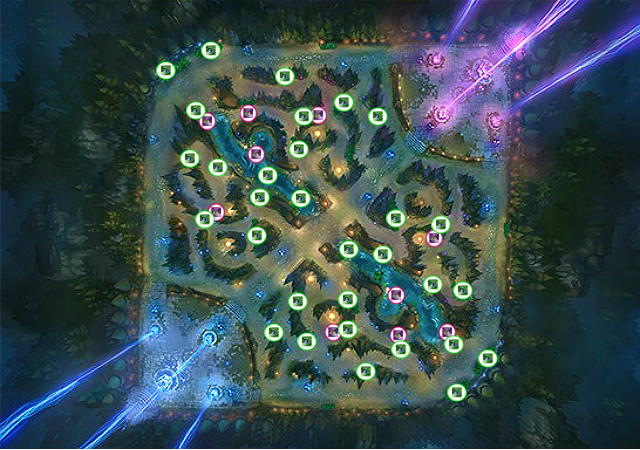

The best places for ordinary Sight Wards. Usually in bushes or in gateways. A proper Ward placement can secure two lanes with just one or two Wards.

The best places for Vision Wards. Close to strategic locations (Buffs, Dragon, Baron). Taking control over them is very important.
Of course, Sight Wards and Vision Wards placement is optional and can be adjusted, if needed. If the opposing team sets a Ward in a given location, you can place there your Pink, and thus deny them their vision. The same is true for strategic locations on the map - if you do not have any Vision Wards, you should still set there a Sight Ward to provide good map visibility. When this is destroyed, you will then know that enemies secured that territory with their own Pink and you should eliminate it.
This is because you do not want to weaken a fellow ADC, by taking away his farming opportunity or by last hitting enemies. Each Support should do everything he can to weaken an enemy and let his own ADC get the gold. If your lane partner for some reason is unable to do that, you should deliver the final blow to an enemy, but avoid that in any other circumstances, not to mention doing that on purpose. If any of the two should grow stronger than the other, it is definitely ADC.
Supports are not made to deal damage. This role belongs to other teammates. You will support them by attacking from a distance, not by spearheading an attack.
Typical Supports
At their disposal they have auras, absorption shields, healing, and crowd control abilities. These Supports are really helpful with farming. Some great examples are:

Offensive Supports/Tanks
Their attacks are stronger and their crowd control abilities last longer. Additionally, they can take more damage. Supports of this type usually initiate combat first and often find themselves in the eye of the storm. This group of champions include:

Untypical Supports
These are champions who usually play a different role, however, thanks to their abilities, they can additionally support their team. Although they rarely have positive auras, healing, etc., they can deal some heavy damage instead. Some examples are:

Junglers are difficult to define. They do not earn experience or gold from being on a lane and farming minions. Instead, they runsack small camps in the jungle, inhabited by neutral creatures. This is why practically every Jungler chooses summoner ability called Smite. This spell makes Jungler's job significantly easier. This is also an invaluable help when fighting the Dragon or the Baron. The Ancient Golem's camp and the Elder Lizard's camp appear in minute 1:55, while the rest in minute 2:05 of a game. Note that the more often you visit a camp, the less gold and experience you get from them. If a Jungler happens to gank a lane, while the camps are left alone, he will get some extra experience and gold when he returns there.

Wolf Camp

In the wolf camp there is large big predator and two smaller ones. They fight at close quarters. Killing the former grants much more gold and experience than killing the other two. Additionally, the bigger wolf restores some health to the champion who killed it. Wolves respawn after 50 seconds.
Wraith Camp

In wraith camp there is one large ghost and three smaller ones. When attacked, they respond with projectile attack. Similarly to wolves, the biggest wraith grants more experience and gold, as well as regenerates some of his killer's health. Wolves respawn after 50 secons.
Golem Camp

This camp is inhabited by only two creatures, although these are stronger than the other ones. The larger golem grants experience and gold bonus, as well as small health regeneration. The smaller of the two is worth a little bit more than lesser creatures from other camps. Golems respawn after 50 seconds.
Elder Lizard's Camp

This camp is inhabited by a large lizard with red aura, as well as two smaller creatures of the kind. Killing the largest one grants you Red Buff, which causes your auto attacks to slow down your target and deal true damage over time. Just like other big creatures, it regenerates a small portion of health for its killer. The lizards respawn after 5 minutes.
Ancient Golem's Camp

This camp is occupied by a huge golem with blue aura and two lesser lizards. Killing the golem grants Blue Buff, which provides a bonus to mana/energy regeneration, as well as shortens ability cooldowns. Additionally, a portion of killing champion's health is regenerated. Just like the lizard, the golem respawns after 5 minutes.
Dragon

The Dragon lives in a bay by the river, close to the Bottom. This is a much more powerful opponent, especially for low level champions. Its health bar grows along with champions' levels. He also has a unique ability which causes champions who are hit by dragon fire to burn and receive true damage, as well as suffer 20% decrease in attack speed. Killing the Dragon grants no buffs, but instead, the entire team gets 190 gold. The Dragon spawns in minute 2:30, and respawns after 6 minutes.
Baron Nashor

Definitely the strongest of all neutral creatures. Its bay is close to the Top. Baron has some unique abilities which deal damage to attackers, reduce their physical damage by 50%, airborne all champions or push them back into various directions. Fighting the Baron requires a great deal of cooperation. This target should not be fought untill late game. Killing Baron grants 300 gold to all members of the killing team, as well as Baron Buff to those still alive. This provides bonus to physical/magical damage, as well as a speed-up to health and mana regeneration. Baron spawns in minute 15 and respawns after 7 minutes.
Many champions can play as Junglers. Some of them initially go to the Ancient Golem's camp, others to the Elder Lizard's camp, to quickly get helpful auras. In early game they usually use teammates' help, who lure out the creatures from their camp to distruct them and make easier to finish off by a Jungler. A good Jungler knows his limits and uses his abilities carefully, in order to clear several camps and still be ready to gank an enemy on one of the lanes. Typical Junglers have various power-ups at their disposal, such as absorption shields, life stealing, and even healing. Additionally, most of them are able to deal area damage. Taking on this role requires decisiveness (and making right decisions!) and even more importantly - effectiveness. A team has no use of a champion who would not stick out of the jungle during an entire game. If, in turn, they choose to help their teammates to outnumber enemies on lanes, by showing up in different places, they will hinder enemy development, because the opponents will have to play much more carefully. Playing as a Jungler requires to be a sly dog, e.g. stealing creatures from enemy jungle (Counter Jungling), so to slow down enemy development. To successfully do this, you should kill only the biggest of the creatures from a camp, leaving the rest be. Untill the enemy finishes off the remaining lesser creatures, the bigger one will not respawn.
Typical Junglers
Champions from this group are marked by high endurance. They support their team by distracting enemies, creating opportunities to eliminate them, but letting their teammates do deal damage. This group includes e.g.:

Offensive Junglers
Able to deal huge famage. They are often picked when there is an enemy Tank on the Top. Examples of this type of Junglers are:

Everyone can find a champion just for themselves in League of Legends. At the beginning of your adventure you may want to use your facebook account to get a free champion and an additional skin. You just need to 'like' LoL's account (https://www.facebook.com/leagueoflegends), and then click on "Free Riot Girl Tristana" button. Now you need to choose the right server and log in, if necessary. Another free champion is Alistar. You can get him by subscribing RIOT YouTube channel. Just choose one of the links corresponding to servers (EUW - http://euw.leagueoflegends.com/youtube, NA - https://na.leagueoflegends.com/YouTube, EUNE - https://eune.leagueoflegends.com/YouTube) and click on "Subscribe" button. These two simple operations will grant you two champions to start with. Every Tuesday RIOT releases 10 champions in so-called free champion rotation, available for a whole week. After 7 days, if you really like one of them, you have to buy the champion to use it further. You may also want to check recommended champions - mastering them should not be a problem.
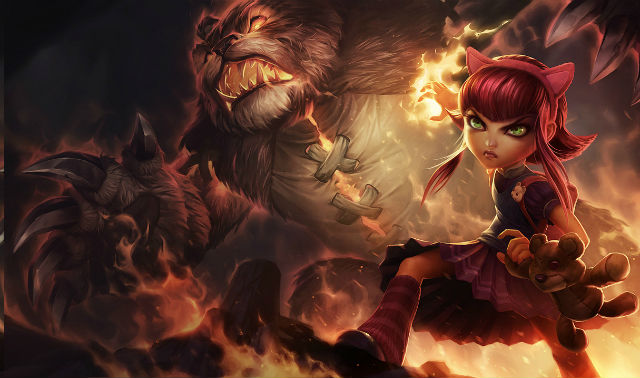
Basic information
Strengths
Weaknesses
Difficulty level: Low
Mobility: Low
CC: Medium
Damage: High
Endurance: Low
Damage type: AP
Recommended roles: Mid
+ Huge damage
+ Good at 1 vs. 1 encounters
+ Easy farming with Q button
- Low endurance
- Quickly runs out of mana in early game
- Weaker damage, when you do not use her passive ability properly
Annie is a Mage (magical damage). Owing to her abilities she can quickly terminate an enemy. Annie is able to keep opponents in one place long enough to gain advantage for her team. Her basic ability is Disintegrate (Q), which is a great help with farming. Finishing off a minion with Disintegrate restores the mana spent on the spell. Incinerate (W) is a fine area damage ability. In later game this really comes in handy with clearing a lane out of minions. Thanks to Molten Shield (E) Annie gains additional magic resistance and deflects some of enemy's basic attacks. Finally, she has a Summon Tibbers (R) ability. This is what makes Annie a real threat to her enemies. A properly used Tiber can devastate opponents. On the other hand, Tiber is very friendly and helpful to Annie's teammates. Gold should be spent on items, which add bonuses to magical damage, life, and mana, as well as those which lower cooldowns.
Strategy:
Initially, it is best to focus on farming using auto attack and Q. After you have used four abilities and charged up stun, you might want to scare your enemy and push him back to defensive position. If he comes any closer, you can punish for that him with Q->W combination.
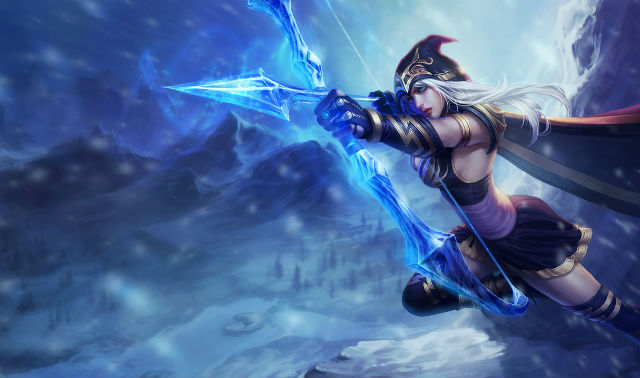
Basic information
Strengths
Weaknesses
Difficulty level: Low
Mobility: High
CC: High
Damage: Medium
Endurance: Low
Damage type: AD
Recommended roles: ADC
+ Slow, stun
+ Great at PvP
+ Easy farming (W)
- Vulnerable to damage
- Initially weaker than other ADC; this requires a careful approach
- Gets stronger only later in game
Ashe serves as a long ranged ADC. In early game she is a bit weaker than other ADC, but controlling her is easier. Later in game, she reveals her true potential. One of Ashe's abilities is Frost Shot (Q), which can temporarily slow down an enemy. Another very useful ability is Volley (W) - it enables Ashe to attack several targets at once. Note that arrows stop at the first opponent on their way, so they will not hit a champion standing directly behind a minion. Hawkshot (E) can be used for scouting. Sending the arrow in a given direction will illuminate the area, revealing any possible danger. Finally, Ashe has Enchanted Crystal Arrow (R), which is best for initiating a team fight. Well-aimed arrow can stun up to several opponents, giving an upper hand to your team. Note that the time of stun depends on the distance the arrow has covered. The farther the target, the longer the stun is. The arrow can actually fly across the entire map. Gold is best spent on items which add bonuses to physical damage, attack speed, critical chances, and life steal.
Strategy:
When Ashe is out of combat she gains focus stacks, which, in turn, increase the chance of critical hits. Remember that you should attack your enemy first to use that advantage. After the first attack it is best to focus on farming and harassing enemies by W->AA.

Basic information
Strengths
Weaknesses
Difficulty level: Low
Mobility: Medium
CC: Low
Damage: Medium
Endurance: High
Damage type: AD
Recommended roles: Fighter
+ Easy to play
+ Strong in early game
+ Silence (Q)
+ Area damage
- Can be easily avoided
- No long ranged abilities
- Less effective later in game
Garen is very strong and easy to play. As a Fighter he focuses on dealing physical damage. Since auto attack is not his strong side, he relies more on his abilities. Garen's strength lies in simplicity of mechanics, which minimizes the risk of making a mistake. His abilities do not use mana or energy, so they can be used as soon as cooldown ends. Garen has a useful passive ability which speeds up his health regeneration when he stays out of combat for at least 10 seconds. This is a great help when you want to stay on a lane but you do not have much health. All you need to do then, is hide in bushes or stand near a friendly tower and wait. One of the best abilities Garen has is Decisive Strike (Q), which increases his movement speed and silences an enemy upon hitting. This works best in combination with Judgement ability (E), which makes Garen rotate and hit all enemies in range. Courage (W), gives Garen absorption shield, very useful at close quarters. His final ability is Demencian Justice (R), which can finish off an enemy who has low health. Gold spendings should be well-balanced between damage and survival aids. Investing only in damage may turn Garen into an easy target.
Strategy:
Garen exceeds at strength, especially in early phase - and this should be well-used. He is perfect at clearing lanes out of minions using E. The basic combination of abilities for combat is Q -> E.
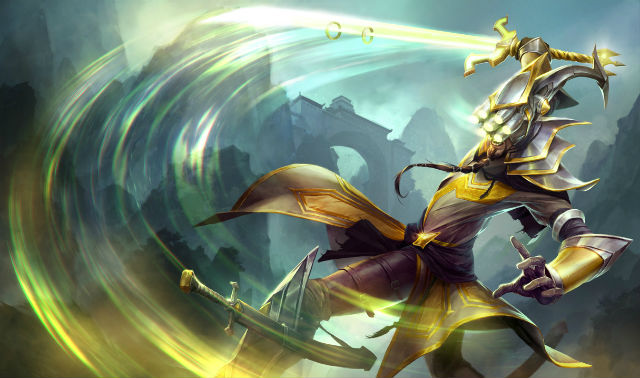
Basic information
Strengths
Weaknesses
Difficulty level: Medium
Mobility: High
CC: None
Damage: High
Endurance: Low
Damage type: AD
Recommended roles: Assassin
+ One of the fastest champions in game
+ Immune to slow (R)
+ A real threat in late game
- Vulnerable to damage
- Long cooldowns
- High dependance on mana
The strength of this frail-looking bladesman lies in his attack speed. Sadly, his abilities have long cooldowns, so he mostly relies on his auto attack. The rule is simple - the faster he attacks, the more damage he deals. Master Yi has several useful abilities among which there is Alpha Strike (Q), which hits several targets at once. This ability is perfect for reducing the distance to your enemy - the champion instantly moves toward the opponent. Meditate (W) restores some health, which is especially helpful in dire situations. The third ability is Wuju Style (E), which increases Yi's damage. Yet, the pinnacle of Master Yi's mechanics is his final ability - Highlander (R). This increases his movement and attack speed. Master Yi is an assassin type of champion, so his main job is to eliminate targets as quickly as possible. As for spending gold, you should first focus on items which grant bonuses to damage, critical chance, attack speed, and life steal. Such combination will turn Master Yi into a deadly killing machine.
Strategy:
Initially, you should focus on farming gold, so you could then buy items which increase damage. Using Q to harass enemies is a good idea too. If you receive much damage, you can quickly restore your health by using Meditate, and get back to fight.
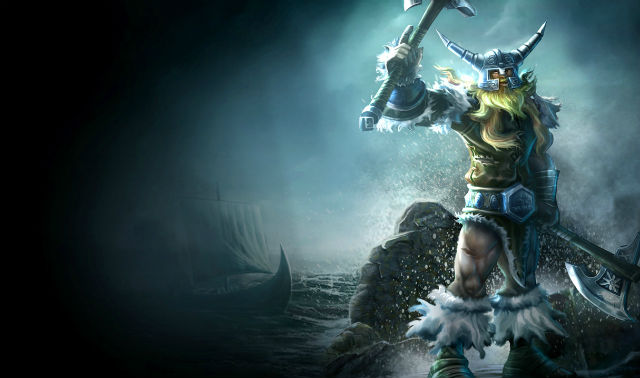
Basic information
Strengths
Weaknesses
Difficulty level: Low
Mobility: Medium
CC: Low
Damage: High
Endurance: High
Damage type: AD
Recommended roles: Fighter
+ Strong in all phases
+ High survivability
+ High damage
+ Easy farming (Q)
- Undertow requires aiming
- Dependance on mana
Olaf is a typical barbarian, whose arm is much more powerful than brain. His mechanics is based on brute force, so in most cases he will be rushing toward an enemy with a war cry on his tongue and axe in his hand, and then bashing his victim until the poor guy drops dead. Olaf's abilities are just as simple as his personality. One of them (Q) is a long ranged axe throw, which additionally slows down an enemy upon hitting. He can then strike his victim with two axes (E). Vicious Strike (W) regenerates Olaf's health with every hit. Finally, Ragnarok (R) activates Olaf's battle rage making him immune to crowd control abilities. The biggest true damage is dealt by Reckless Strike (E). Gold should be spent on items increasing survivability. You should find the perfect balance between extended health bar, different types of resistance, and damage.
Strategy:
Olaf is deadly in early game. Through Q->E combination he can deal massive damage which ignores enemy armour. If an opponent dares to approach too close, you can just bash him in the head (E) to teach him a lesson. When treated like that, the enemy will quickly run for cover.

Basic information
Strengths
Weaknesses
Difficulty level: Medium
Mobility: Low
CC: Medium
Damage: High
Endurance: High
Damage type: AP
Recommended roles: Mage
+ Abilities that do not require manual aiming
+ Area damage
+ No problems with mana
+ High survivability
- Short range of distance abilities
- Weaker in early game
- High dependance on items
Ryze is an untypical champion, since he is a hybrid of a Mage and Tank. His abilities grow in power along with his mana bar, and consequently he has much less problems with mana than other mages. His uniqueness results in his ability to deal massive damage in short time, and at the same time, stand fast in the heart of the battlefield. Ryze has Rune Prison (W) at his disposal, which enables him to temporarily lock an enemy in a cage and cast spells at him undisturbed. The Rouge Mage's final and most spectacular ability is Desperate Power (R), which makes him a real threat to an enemy. When the ability is active, the champion will regenerate some damage upon hitting, and area damage will be added to all his abilities. Gold should be spent on items which increase mana and health bars, magical damage, as well as various types of resistance.
Strategy:
The early game is the most challenging for this champion, so he should focus on farming, and use Q->W->E->AA->Q combination whenever approached by an enemy.
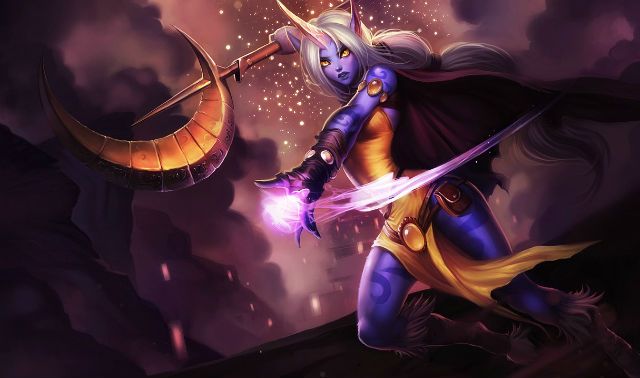
Basic information
Strengths
Weaknesses
Difficulty level: Low
Mobility: Low
CC: Low
Damage: Low
Endurance: Low
Damage type: AP
Recommended roles: Support
+ Abilities enabling her to stay on a lane for a long time
+ Healing and mana restoration
+ Silence
- High vulnerability to damage
- No crow control abilities
Soraka is a great support, who can find her place in every team. Her basic functions are: healing, restoring mana, and harassing enemies with auto attack, as well as silencing them. This champion does not deal huge damage and should not stay on frontline. Soraka feels best while standing aside, where she can use her abilities undisturbed. One of her offensive abilities is Starcall (Q), which deals magical damage to all nearby targets. The most important ability is Astral Blessing (W), which heals teammates and improves their armour. Another ability - Infuse (E) - either restores teammates' mana or, silences an enemy and deals magical damage to them. The final Soraka's ability is Wish (R). This can really frustrate Soraka's enemies, because it heals all her teammates, even those on the other side of the map. It is best to spent gold on items which cast positive auras on teammates (improved resistance, damage, etc.), as well as those extending Soraka's mana bar, so she could effectively use her spell.
Strategy:
Soraka's main goal is to support teammates on her lane, and that is exactly what she should do. When paired with an ADC, she can both effectively protect a lane and farm.
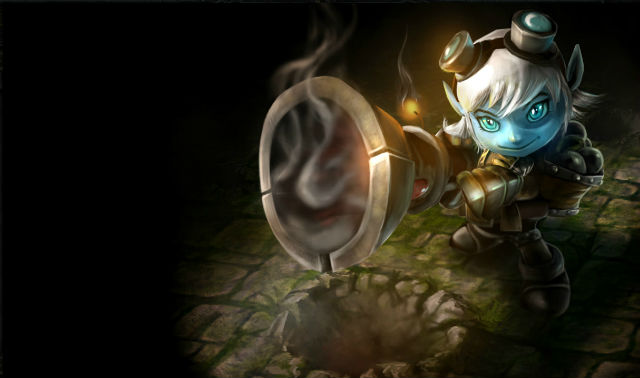
Basic information
Strengths
Weaknesses
Difficulty level: Medium
Mobility: High
CC: Low
Damage: High
Endurance: Low
Damage type: AD
Recommended roles: ADC
+ High damage in early and late game
+ Abilities that enable quick escape (W/R)
+ High effectiveness at clearing lanea out of minions (E)
- Vulnerability to damage
- Dependance on mana
Tristana is one of the easiest ADC. Her true power is revealed in late game. Her main source of damage is her auto attack, although she has some interesting abilities helpful in combat. The basic one is Explosive Shot (E) - this not only deals much damage, but also causes enemies to blow out when killed, delivering additional area damage. The next important ability is Rocket Jump (W) allowing her to jump to a current target, or jump off to safety. Through Rapid Fire (Q) Tristana greatly improves her attack speed, which can be really useful in duels. Her final ability is Buster Shot (R), which both harms and pushes back all surrounding enemies. This ability combined with Rocket Jump can make Tristana really hard to get. Gold is best spent in items increasing damage, critical chance, attack speed, and life steal.
Strategy:
Just like any other ADC, Tristana has to focus on farming and not watch out not to get pushed near a friendly tower. It is best to try to hold minions waves in the middle of a lane, so Tristana had some free space to jump back (W) when jeopardized. It is also good to harass enemies with E->AA combination.
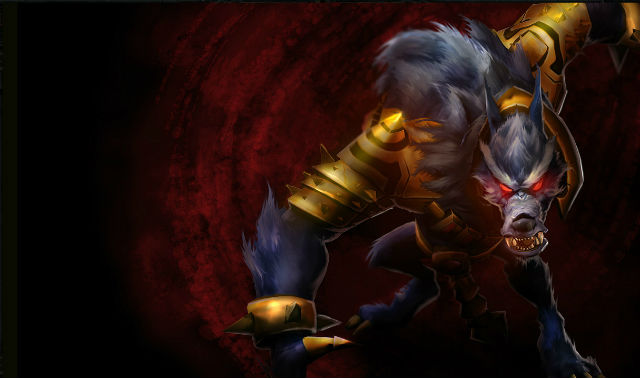
Basic information
Strengths
Weaknesses
Difficulty level: Low
Mobility: High
CC: Low
Damage: Medium
Endurance: High
Damage type: AP
Recommended roles: Jungler / Solo laner
+ High survivability and endurance
+ Target suppression (R)
+ Real pain in enemy's backside
- Lower effectiveness in late game
- High mana dependancy
Warwick is a blood hunter with extremely high survivability. As any werewolf, he is bloodthirsty, and there is no better blood source on Summoner's Rift than enemies. Dealing damage restores his own health, which makes him a challenging opponent. Regardless of simple mechanics, he is a really effective champion. All his abilities require mana, so you always need to keep an eye on mana bar. When he smells blood (E) Warwick goes berserk, which makes him speed up whenever there is a wounded enemy nearby. Because of this it is very difficult to run from the werewolf. With Hungering Strike (Q) Warwick deals high magical damage, which restores his own health. This increases his survivability and enables to stay on a lane longer than his enemies. Hunter's Call (W) significantly improves the champion's attack speed. Warwick's last ability is Infinite Duress (R). This enables him to instantly jump toward an enemy, knock him over, and rip into pieces, healing himself at the same time. Gold is best spent on items which grant healing and mana bonuses, as well as improve magic damage and various types of resistance.
Strategy:
In early game it is best to farm with auto attack, and, when needed, assault an enemy with Q to restore some health or simply deal damage. Note that the ability consumes mana, so it should be used with moderation.
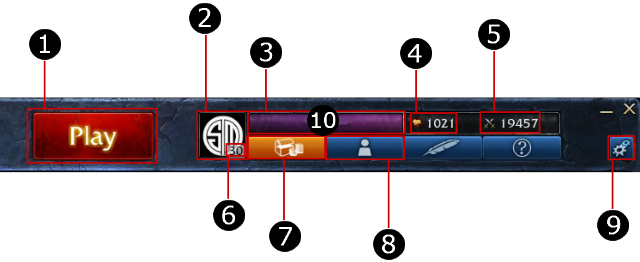
Each summoner starts from account level 1 and keeps progressing till level 30, which is the maximum level. Participation in games (both won or lost) is rewarded with experience points, represented as a purple progress bar, on top of which player's nick is displayed. Apart from experience, players also get Influence Points (IP), which are needed to purchase champions, runes, or runebook pages. Main panel displays only basic information; other screens are described further in player profile section.
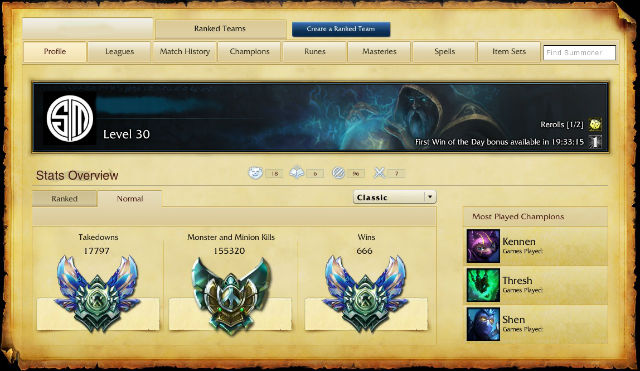
Player profile tab includes basic information about won games - both normal and ranked - number of minions and neutral creatures killed, as well as other players killed. Here you can also learn when IP bonus will be granted for first win of the day, and check the available rerolls for ARAM game mode. Beyond that, there are several other tabs.
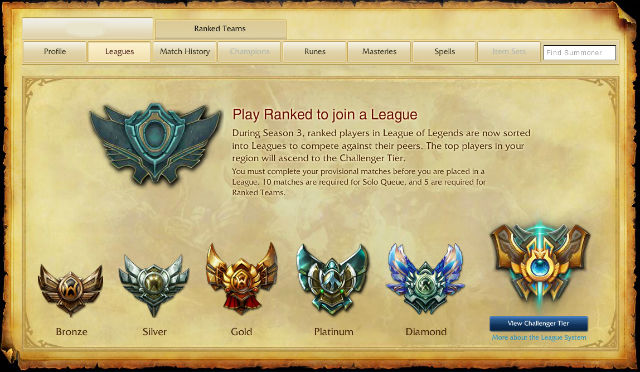
Here you can find information about your current league. To participate in league games, you need to reach profile level 30 and own at least 16 champions. If you meet these requirements, you will have to play 10 placement games, which will determine your skill and assign to a proper league. League games rules are described in earlier chapter, devoted to game modes.
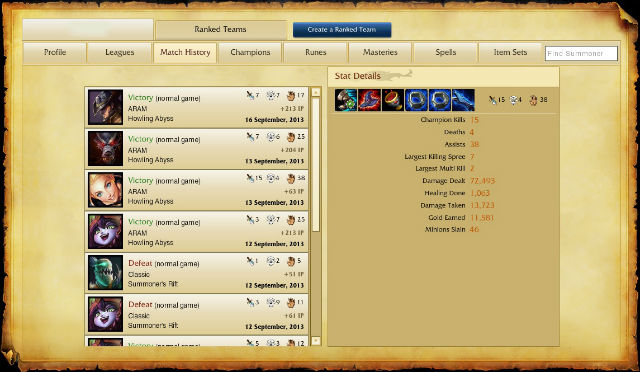
This tab contains information about last 10 matches. These are scores, number of kills, assists, and deaths, as well as IP gained. Clicking on one of the matches on the right side of the screen reveals additional information, such as sum of all damage points dealt to enemies, creatures killed, and gold gathered. You can also learn which items were used by a given champion in the game.
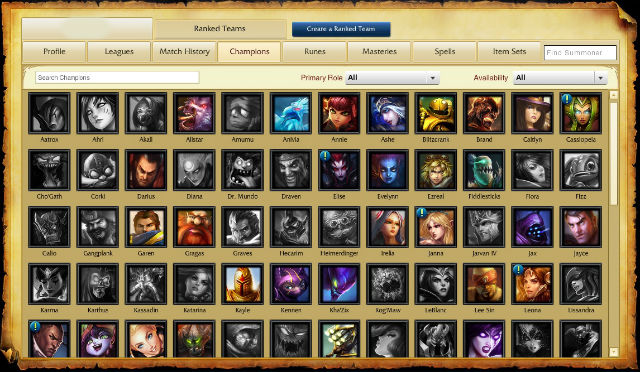
This tab contain list of all the champions in the game. Characters who are not in your possession are marked on grey, whereas the coloured ones are those already unlocked. An exclamation mark in the left corner of a champion's portrait means that they are currently in weekly free pool. Clicking on one of the portraits will reveal detailed information on the champion.
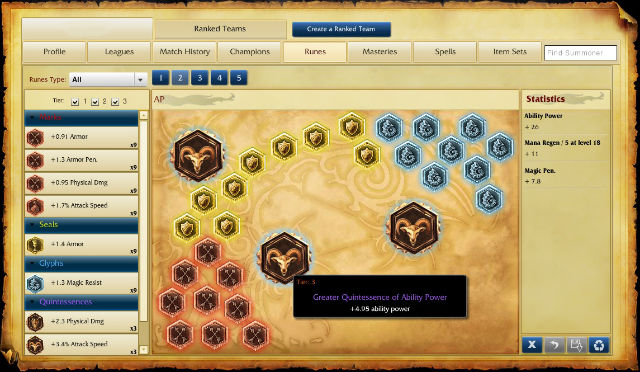
This is the runebook screen. On the left hand side there is a drop-down list with all your runes. Initially, every summoner has only 1 card - more can be purchased in the store with IP or RP. Rune pages can be changed, renamed, and saved before battle begins. They are available on the champion selection screen. The picture in this chapter shows an exemplary mage's rune card. Here, the stress has been put on magical penetration boosts (Marks), magic power boosts (Glyphs and Quintessences), and mana regeneration boosts (Seals).
Rune types:

Marks: also called Red runes; they grant the highest bonuses to attack statistics, such as physical damage, armour penetration, and magical penetration. Each card can hold 9 runes of the type.

Seals: also called Yellow runes; they grant the highest bonuses to defensive statistics, such as armour and health bar extention. Each card can hold 9 runes of this type.

Glyphs: also called Blue runes; they are the best to reinforce magic power and magic resistance. 9 runes of the type can be assigned to each card.

Quintessences: also called Quints; they grant much greater bonuses to all above statistics, as well as to some others, such as life steal and movement speed. Each card can hold only 3 Quintessences.
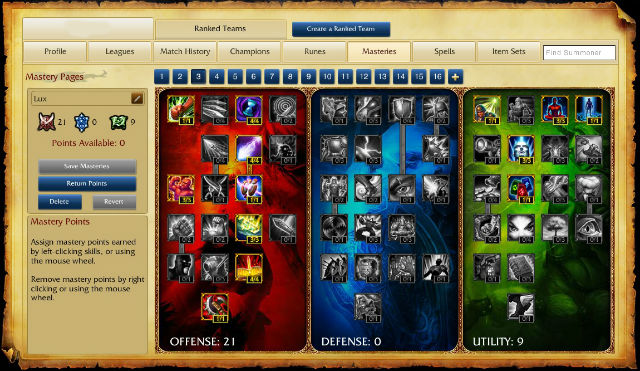
With each profile level players are rewarded with so-called Masteries Points, so you can have as much as 30 of them. They can be assigned freely into 3 mastery trees: Offense, Defense, and Utility. You can have up to 20 Mastery Pages, which can be created for free (unlike rune pages, they do not need to be purchased). Masteries can be freely changed and adjusted to needs of particular champions, even right before a game starts, during champion selection. In one of the pictures in this chapter there is an example of a mage's Masteries tab. Here, 21 points have been distributed in Offense tree, in order to increase magic power, damage, and magic penetration, as well as lower cooldowns. Defense tree has been skipped, and the remaining 9 points were spent in Utility tree, so as to improve mana regeneration, reduce summoner spells cooldowns, and increase duration of buffs by 20%.
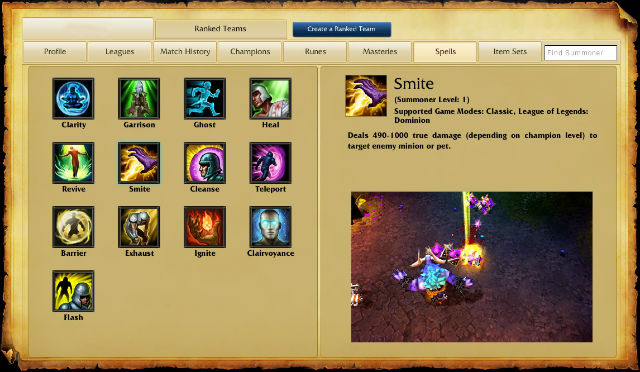
Each player can choose 2 from 13 available spells before a game starts. Using them is completely free, that is, they do not use mana, energy, nor champion's health. All spells differ in their effect and the duration of cooldown - the latter varies from 60 seconds to 5 minutes.
Icon
Name
Map
Description

Ghost
Summoner's Rift, Twisted Treeline, Crystal Scar, Howling Abyss.
Champion gets 27% bonus to movement speed for 10 second. He can also ignore unit collision (minions).

Heal
Summoner's Rift, Twisted Treeline, Crystal Scar, Howling Abyss.
When activated, restores from 90 to 345 (depending on champion's level) health points to the champion and all nearby allies.

Clarity
Summoner's Rift, Twisted Treeline, Crystal Scar, Howling Abyss.
When activated, immediately restores 40% of the maximum mana to the champion and all nearby allies.

Garrison
Crystal Scar.
When used on friendly tower significantly increases its regeneration for 8 seconds. When used on enemy tower decreases the damage it deals by 80% for 8 seconds.

Revive
Summoner's Rift, Twisted Treeline, Crystal Scar, Howling Abyss.
Immediately revives the champion and gives him 125% movement speed bonus for a short time.

Smite
Summoner's Rift.
Used on a minion or a neutral creature immediately deals from 490 to 1000 (depending on champion's level) true damage.

Cleanse
Summoner's Rift, Twisted Treeline, Crystal Scar, Howling Abyss.
Immediately removes all negative effects from the champion, and decreases duration of such effects received in next 3 seconds by 65%.

Teleport
Summoner's Rift.
After 4 seconds from activation teleports the champion to a friendly creature, tower, or ward.

Barrier
Summoner's Rift, Twisted Treeline, Crystal Scar, Howling Abyss.
Gives the champion a shield, which can absorb from 115 to 455 (depending on champion's level) damage for 2 seconds.

Ignite
Summoner's Rift, Twisted Treeline, Crystal Scar, Howling Abyss.
Instantly ignites an enemy, deals from 70 to 410 (depending on champion's level) true damage for 5 seconds, and lowers efficiency of their healing spells, healing effects, and health regeneration.

Exhaust
Summoner's Rift, Twisted Treeline, Crystal Scar, Howling Abyss.
Instantly weakens a target reducing his movement speed and damage by 30%, as well as lowering attack speed by 50% for 2,5 seconds.

Clairvoyance
Summoner's Rift, Twisted Treeline, Crystal Scar, Howling Abyss.
Instantly unveils a chosen portion of the map for 5 seconds.

Flash
Summoner's Rift, Twisted Treeline, Crystal Scar, Howling Abyss.
Teleports the champion a short distance in the direction of your cursor. Flash can be used to move to the other side of small obstacles or walls.

The last tab contains item sets, adjusted to particular champions. The entire list can be found in the store after a game begins. This significantly facilitates shopping and saves time, since players do not have to browse the entire content of the store to find items they need. In the picture from this chapter you can see an exemplary item set adjusted to Supports. The focus is on buying Wards along with items improving armour and movement speed.

This is where summoners can purchase new champions or change their appearance with new skins, as well as replenish runes or add new slots to the runebook. Beyond that, there are boosts to IP and experience points earned. Here, you can also buy some RP, or use promo codes. This is where you can learn about current promotions, as well as best-selling champions and skins. There is also Gifting Center in the store, where every summoner on level 20 or higher can give someone a gift - e.g. an additional champion or a rare skin.
League of Legends is currently the most popular MOBA and e-sport in the world. This is why it is possible to find many useful websites, which contain a lot of interesting information, or even give some insight into your current opponent.
http://www.lolnexus.com/ - this website contains browser of currently in-progress games on all servers. While in match, you can minimize the game, type in your summoner's name, and get information on your current opponents. This includes their league, number of battles won, and whether they joined the game solo or together with friends.
http://lolcounter.com/ - here you can find details on countering particular champions. It is good to look up some information on the champion you are going to fight against. The site also prompts which items to buy and which to avoid.
http://eune.lolesports.com/ - a website dedicated to e-sport. You can find there current tournaments, as well as get info on future events.
http://www.twitch.tv/directory/game/League%20of%20Legends - this is where the best players from around the world stream their games. Here, you can watch how pro-gamers play as particular champions, which items they buy, and what tricks they use. Watching them in action can be a really good lesson.
http://www.youtube.com/user/Protatomonster?feature=watch - YT channel, with short videos of Top 5 Plays Of The Week.


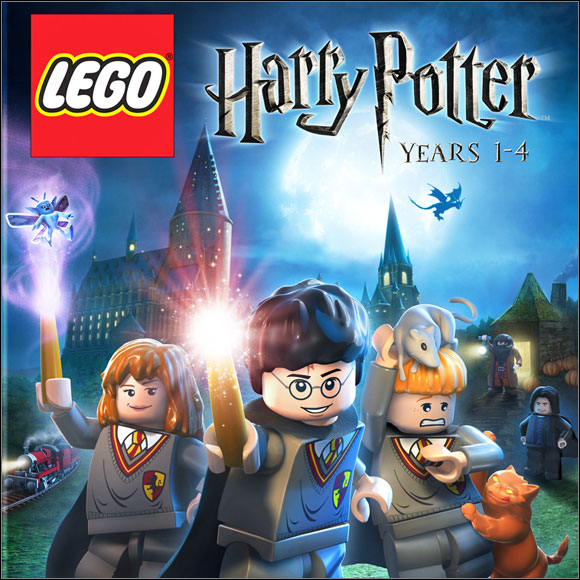
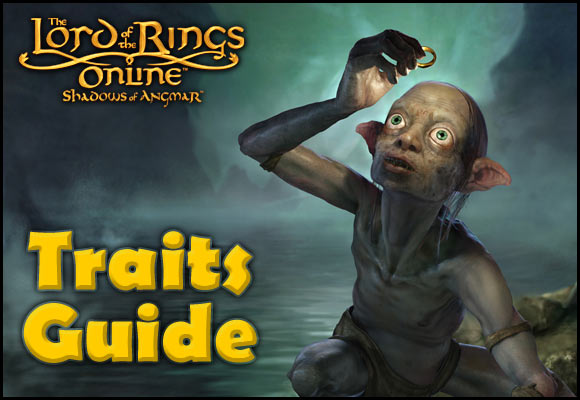
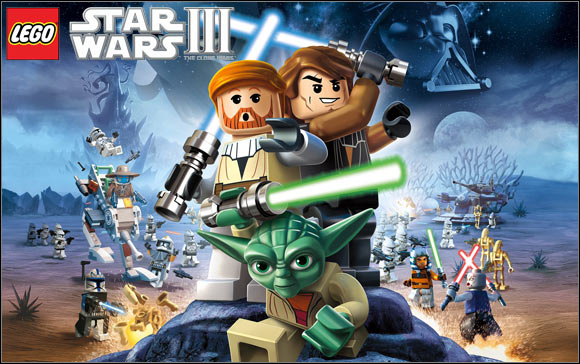 LEGO Star Wars III: The Clone Wars Game Guide & Walkthrough
LEGO Star Wars III: The Clone Wars Game Guide & Walkthrough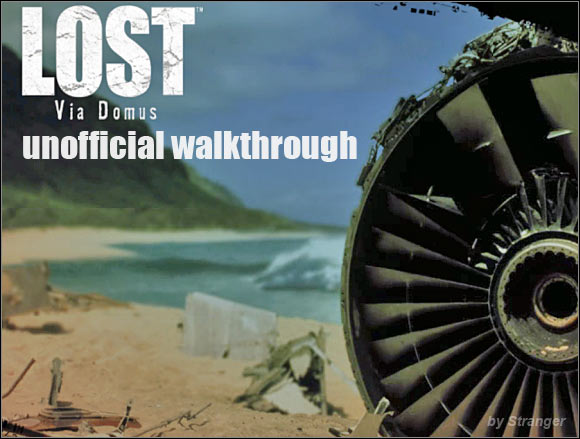 Lost: Via Domus Game Guide & Walkthrough
Lost: Via Domus Game Guide & Walkthrough Lord of the Rings Online: Traits Game Guide & Walkthrough
Lord of the Rings Online: Traits Game Guide & Walkthrough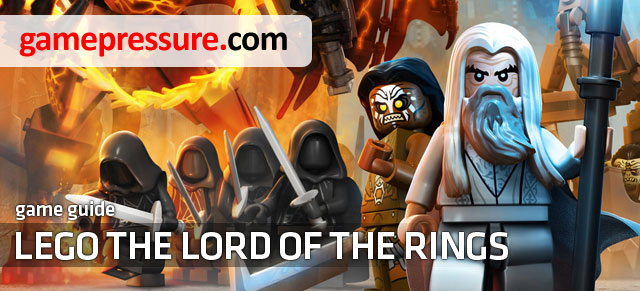 LEGO The Lord of the Rings Game Guide & Walkthrough
LEGO The Lord of the Rings Game Guide & Walkthrough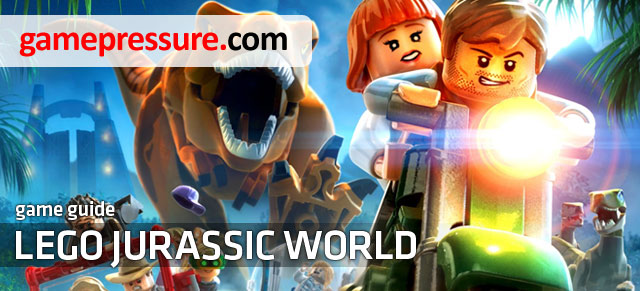 LEGO Jurassic World Game Guide & Walkthrough
LEGO Jurassic World Game Guide & Walkthrough